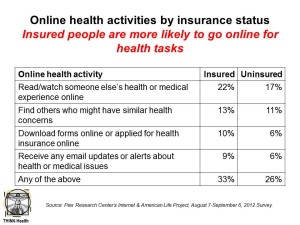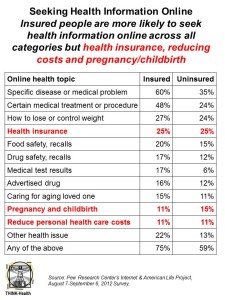
1 in 3 U.S. adults have enough trust in online health resources that they’ve gone online to diagnose a condition for themselves or a friend. “For one-third of U.S. adults, the Internet is a diagnostic tool,” according to Health Online, the latest survey on online health from the Pew Internet & American Life Project.
Nearly one-half of these people eventually sought medical attention. One-third did not. Women are more likely to do online medical diagnoses than men do, as do more affluent, college-educated people.
When people perceive they’re ‘really’ sick, 70% get information and care from a health professional and 60%, from friends and family. 24% seek help from fellow peer-patients.
This profile of online health seeking behavior is brought to you in the latest version of the pre-eminent poll on the Internet and health led by Susannah Fox of the Pew Internet & American Life Project. Susannah has led this research for the Pew Internet program since 2000 and has a longitudinal appreciation and knowledge base on the topic.
This year, Fox and colleagues polled consumers on their health insurance status for the first time: a subject closely monitored by Health Populi. Thanks for including the question, Susannah!
Overall, one-third of insured people go online to conduct various health tasks, compared with 26% of uninsured people who do so. The table illustrates that having health insurance has a positive influence on consumers’ online health information seeking — especially the social aspect of tracking other patients’ health experiences. 22% of insured adults read or watched someone else’s health experience online compared with only 17% of the uninsured. There’s also a gap between people using the Internet for conducting administrative tasks online, such as downloading forms or applying for health insurance (10% vs. 6%), and receiving email updates about health issues (9% compared to 6%).

While education level and income are correlated to people looking online to diagnose a health condition, it’s important to note that income and education don’t make a big difference in people seeking medical professionals’ opinions once the consumer has self-diagnosed. Roughly one-half or more people who have done online diagnoses and earn annual income over $30K follow up with a clinician, and 1 in 2 people with at least a high school diploma see a clinician post-Internet diagnosis.
Insurance status doesn’t make a difference when it comes to self-diagnosing online: roughly the same proportion of people with or without health insurance are likely to go online to self-diagnose. However, as the second chart shows, greater proportions of insured people tend to seek health information online compared with uninsured people except for the topics health insurance, reducing health care costs, and pregnancy and childbirth.
Methodology: the 2012 Health Survey was sponsored by Pew & the California HealthCare Foundation. Telephone interviews were conducted via landline and cell phone among 3,014 U.S. adults in August and September 2012.
Health Populi’s Hot Points: While many aspects of consumers’ relationship with the online health world have been stable for the past two or three years, several findings in this year’s poll should be called out as they either reverse trends or represent intriguing new directions:
- The percent of U.S. adults consulting online reviews of particular drugs or medical treatments significantly fell from 24% in 2010 to 18% in 2012. This represents a 25% decrease, which Pew finds statistically significant between the years. The question here for pharmaceutical manufacturers is, “why?” I hypothesize this is because many very popular drugs have gone generic in the past two years, and at the same time, health consumers have become increasingly price-sensitive to out-of-pocket co-pays for branded pharmaceuticals where the widening co-pay spreads between generic and brand are driving consumers to opt for generic. Mail-order drugs for chronic maintenance medications compel patients to go for generic fill, as well.
- Health consumers in rural areas are far less likely to consult online reviews for drugs/medical treatments, health providers, and hospitals. While it’s understandable why rural residents might not be motivated to seek reviews for doctors or hospitals online due to the reality that these health citizens live in areas that may offer few options beyond the local institution, it is intriguing that this population much less often looks for online information on drugs and treatments. This may be a function of lower socioeconomic status and education among rural health citizens, which represents a different kind of “last mile” problem I put into the health disparity and health literacy challenge. The other side of this coin is that college graduates are more likely to consult online reviews for all aspects of health care compared with people with no or some college.
- The proportion of people using online reviews and rankings remains relatively small at about 18% of people for drugs/treatments, 17% of adults for doctors, and 14% for hospitals.
In the emerging accountable care and Health Information Exchange era, this looks like a huge challenge for consumers who need to embrace transparency and information that helps them navigate the labyrinthine U.S. health system. With the likes of Castlight Health attracting millions of dollars of venture funding, tools are being built to enable the supply side of quality and price information. But will people come? This year’s Pew health survey research reveals: not so many as will need to.




 I'm in amazing company here with other #digitalhealth innovators, thinkers and doers. Thank you to Cristian Cortez Fernandez and Zallud for this recognition; I'm grateful.
I'm in amazing company here with other #digitalhealth innovators, thinkers and doers. Thank you to Cristian Cortez Fernandez and Zallud for this recognition; I'm grateful. Jane was named as a member of the AHIP 2024 Advisory Board, joining some valued colleagues to prepare for the challenges and opportunities facing health plans, systems, and other industry stakeholders.
Jane was named as a member of the AHIP 2024 Advisory Board, joining some valued colleagues to prepare for the challenges and opportunities facing health plans, systems, and other industry stakeholders.  Join Jane at AHIP's annual meeting in Las Vegas: I'll be speaking, moderating a panel, and providing thought leadership on health consumers and bolstering equity, empowerment, and self-care.
Join Jane at AHIP's annual meeting in Las Vegas: I'll be speaking, moderating a panel, and providing thought leadership on health consumers and bolstering equity, empowerment, and self-care.